전염성 홍반(감염성 홍반) Erythema infectiosum(Fifth disease/Human parvovirus B19 infection)
(You may visit www.drleepediatrics.com – Volume 7,
Pediatric Adolescent Infectious Diseases or제 7권, 소아 청소년 감염병 질환 웹사이트)
전염성 홍반의 원인
-
전염성 홍반은 사람 팔보바이러스 B19(Human parvovirus B19) 감염으로 생기는 급성 바이러스성 감염병의 일종이다.
-
전염성 홍반을 5병(Fifth disease)이라고 부르기도 한다.
-
참고로 제 5병이란 병명은 다음과 같은 여섯 가지 발진성 감염병에서 나온 말이다. 홍역은 제 1병, 성홍열은 제 2병, 풍진은 제 3병, 듀크병(Duke’s disease)은 제 4병, 전염성 홍반은 제 5병, 돌발성 발진(장미진)은 제 6병이다.
-
그 중 듀크병은 오늘 날 찾아보기 힘든 병이다.
전염성 홍반의 증상 징후
-
사람 팔보바이러스 B19에 감염된 후 4~21일간 잠복기를 거쳐 약 15~30%에서 열, 피부 발진 등이 나타날 수 있다.
-
사람 팔보바이러스 B19에 감염된 사람들의 기도의 분비물에 접촉되거나 혈액에 접촉될 때 감염될 수 있다.
-
이 바이러스에 감염된 임신부의 경우, 이 바이러스가 모체로부터 태아에게 감염될 수 있다. 특히 임신 첫 6개월 동안에 태아가 이 바이러스에 감염되면 태아수종이 생길 수 있고 약 2~6%에서 태아가 사망할 수 있다.
-
이 바이러스 감염병은 세계적으로 유행한다.
-
사람들에게 감염되면 증상 징후가 있을 수 있고 아무 증상 징후가 없이 감염되어 이병을 알게 모르게 앓고 나을 수 있다.
-
이 바이러스에 감염되어 증상 징후가 있을 때는 열, 근육통, 두통, 관절통, 관절염 등의 증상 징후가 경미하게 나타날 수 있다.
-
뺨, 앞 목, 상부 앞가슴, 어깨, 양 위팔, 몸통, 엉덩이, 허벅다리, 손, 발 등에 특이한 홍반(사진 3-62 ~ 3-69 참조)이 나타날 수 있고, 사람 팔보바이러스 B19에 감염된 후 아무 증상 징후가 없을 수도 있다.
-
이런 홍반은 1~3일간 계속 되다가 자연히 없어지는 것이 보통이다. 드물게는 이런 홍반이 몇 주 내지 몇 달간 계속 될 수 있다.
-
손바닥으로 뺨을 찰싹 맞았을 때 바로 생길 수 있는 안면 홍반과 비슷한 짙은 홍반이 양 볼에 나타날 수 있고, 앞 목, 양쪽의 위팔의 바깥 부위에 레이스 장식 모양이나 그물 모양의 홍반이 나타나서 1~3주간 지속될 수 있다. 사진 3-62~69에서 볼 수 있는 것과 같이 이런 발진은 특이한 홍반이다.
-
때로는 드물게 미열, 두통, 복통, 콧물, 인두통 등 증상 징후가 생길 수 있다.

사진 3-63. 얼굴 뺨에 난 전염성 홍반 발진
Copyright ⓒ 2012 John Sangwon Lee, MD., FAAP
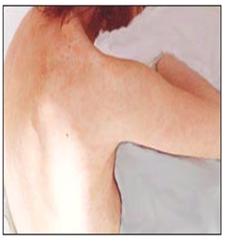
사진3-62.양 어깨와 팔의 바깥 면에 난 전염성 홍반 발진
Copyright ⓒ 2012 John Sangwon Lee, MD., FAAP
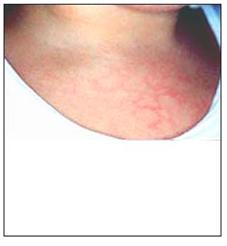
사진 3-64. 목에 난 전염성 홍반 발진
Copyright ⓒ 2012 John Sangwon Lee, MD., FAAP
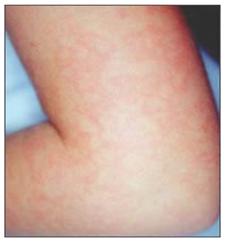
사진 3-66. 위와 아랫팔에 난 전염성 홍반 발진
Copyright ⓒ 2012 John Sangwon Lee, MD., FAAP

사진 3-65. 팔에 난 전염성 홍반 발진
Copyright ⓒ 2012 John Sangwon Lee, MD., FAAP
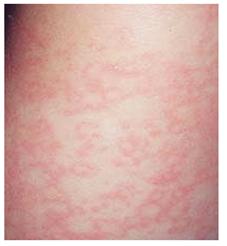
사진 3-67. 팔에 난 전염성 홍반 발진
Copyright ⓒ 2012 John Sangwon Lee, MD., FAAP
표 3-2. 팔보바이러스 19 감염병으로 생기는 병
| 팔보바이러스 19 감염의 종류 | 환자의 면역 상태 |
| 제5병(전염성 홍반) | 면역 적격성이 있는 사람 |
| 다관절 병변 증후군 | 면역 적격성이 있는 사람 |
| 만성 빈혈/순 적혈구 형성 부전증 | 면역 타협성 상태에 있는 사람 |
| 일시적 형성부전증이 있는 경우 | 용혈성 빈혈이 있는 경우 |
| 선천성 태아 수증/선천성 빈혈 | 태아 |
| 지속성 빈혈 | 면역 타협성 상태에 있는 사람 |
전염성 홍반의 진단
-
병력, 증상 징후와 진찰소견 등을 종합하여 진단하는 것이 보통이다.
-
드물게는 환자의 피에서 사람 팔보바이러스 B19 IgM 항체를 검사해 확진할 수 있다.
-
약물 발진이나, 성홍열 발진 , 홍역 발진, 풍진 발진, 돌발성 발진 등의 감염병을 앓을 때 나타날 수 있는 피부 발진과 전염성 홍반으로 생긴 피부 발진을 감별 진단해야 한다.
-
이 병을 앓는 임신부의 태아에게 이 바이러스가 감염될 수 있다. 이 바이러스에 감염된 태아에게 심한 빈혈이 생길 수 있고 태아 수종증도 생길 수 있고 태아가 사망까지 할 수 있다.
-
임신부가 이 병에 걸리거나 이 병을 앓는 사람과 접촉하거나 가까이 있었을 때는 산부인과 전문의의 조언에 따라 적절한 치료와 조치를 취해야 한다.
-
[부모도 반의사가 되어야 한다–소아가정간호백과]-제17권 소아청소년 피부질환–피부 발진과 열이 나는 질병들 참조
전염성 홍반의 치료
-
이 병을 치료할 수 있는 특효약은 없다. 면역 글로불린 정맥 주사 치료에 효과가 있다고 한다. 그러나 대부분의 경우 대증 치료를 한다.
-
대개 자연히 낫는다.
-
백신은 아직 없다.
-
잠복기는 4~21일이다.
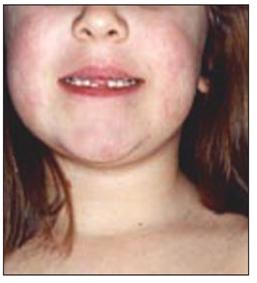
사진 3-68. 전염성 홍반의 발진으로 볼이 붉어져 있다
Copyright ⓒ 2011 John Sangwon Lee, MD., FAAP
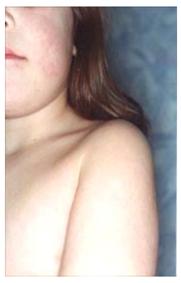
사진 3-69. 전염성 홍반의 발진으로 볼이 붉어져 있다
Copyright ⓒ 2011 John Sangwon Lee, MD., FAAP
|
다음은 “얼굴, 양쪽 뺨이 맞은 것처럼 빨개요 전염성 홍반“에 관한 인터넷 소아청소년 건강상담 질의응답의 예 입니다. |
Q&A. 얼굴, 양쪽 뺨이 맞은 것처럼 빨개요
Q.
안녕하세요?
저희 아이는 7살이구요.
이틀 전부터 양쪽 뺨이 붉게 달아오르며, 입 안쪽도 아프다고 합니다.
소아청소년과에 갔더니, 바이러스에 의한 감염이라고만 얘기하더라구요.
미열도 같이 동반하여 아이의 얼굴이 마치, 사과처럼 보입니다.
왜, 이런 병균이 아이에게 생기는 건지…
평상시 어떡하면 예방할 수 있는지…
큰 병은 아닌지 궁금합니다.
A.
순님
안녕하세요. 질문해 주셔서 감사합니다. 좋은 질문입니다.
자녀의 나이, 성별, 과거 병력, 가족 병력, 진찰소견, 임상검사 등의 정보를 많이 알수록 답변을 드리는데 도움이 됩니다. 주신 정보를 토대로 해서 답변을 드리겠습니다.
혹시 제 5병(전염성 홍반)을 앓고 있는 것 같습니다.
더 자세한 내용은 전염성 홍반,
[부모도 반의사가 되어야 한다–소아가정간호백과]-제17권 소아청소년 피부질환–전염성 홍반, 피부 발진(열꽃)과 열이 나는 질병들 등을 참조하시기 바랍니다.
질문이 더 있으면 다시 연락해 주시기 바랍니다.감사합니다. 이상원 드림
Erythema infectiosum (Fifth disease/Human parvovirus B19 infection) Causes of infectious erythema 전염성 홍반(감염성 홍반)
• Infectious erythema is a type of acute viral infectious disease caused by human parvovirus B19 infection.
• Infectious erythema is sometimes called the Fifth disease.
• For reference, the name of disease 5 comes from the following six eruptive infectious diseases. Measles is the first disease, scarlet fever is the second disease, rubella is the third disease, Duke’s disease is the fourth disease, the infectious erythema is the fifth disease, and the sudden rash (rose rash) is the sixth disease.
• Among them, Duke’s disease is hard to find today. Symptoms signs of infectious erythema
• After infection with human parvovirus B19, fever and skin rash may appear in about 15-30% of patients after an incubation period for 4 to 21 days.
• People infected with human parvovirus B19 can become infected when they come into contact with secretions from the airways or blood. • In pregnant women who are infected with the virus, the virus can spread from the mother to the fetus. Particularly in the first six months of pregnancy, if the fetus is infected with this virus, fetal hydrops can develop, and about 2-6% of the fetuses can die.
• This viral infectious disease is prevalent worldwide.
• When people are infected, they may have symptoms and become infected with no symptomatic signs, so they can get sick and heal without knowing the disease.
• When you are infected with this virus and have symptoms, you may have mild symptoms such as fever, muscle pain, headache, joint pain, and arthritis.
• Peculiar erythema (see photos 3-62 to 3-69) may appear on the cheeks, anterior neck, upper chest, shoulders, upper arms, torso, buttocks, thighs, hands, and feet, and after infection with human parvovirus B19. There may be no signs of symptoms.
• This erythema usually lasts for 1 to 3 days and then disappears spontaneously. Rarely, this erythema can last for weeks to months.
• Dark erythema similar to facial erythema, which can occur immediately when a palm is hit on the cheek, may appear on both cheeks, and lance-shaped or net-shaped erythema appears on the outer areas of the front neck and upper arms on both sides. Can last weekly. As can be seen in pictures 3-62-69, this rash is a peculiar erythema.
• Sometimes, on rare occasions, symptoms such as mild fever, headache, abdominal pain, runny nose, and sore throat may occur.

Photo 3-63. Contagious erythema rash on the cheeks of the face Copyright ⓒ 2012 John Sangwon Lee, MD., FAAP

Picture 3-62: Infectious erythema rash on the outer surface of both shoulders and arms Copyright ⓒ 2012 John Sangwon Lee, MD., FAAP

Photo 3-64. Infectious erythema rash on the neck Copyright ⓒ 2012 John Sangwon Lee, MD., FAAP

Photo 3-66. Infectious erythema rash on the stomach and lower arms Copyright ⓒ 2012 John Sangwon Lee, MD., FAAP

Photo 3-65. Infectious erythema rash on the arm Copyright ⓒ 2012 John Sangwon Lee, MD., FAAP

Photo 3-67. Infectious erythema rash on the arm Copyright ⓒ 2012 John Sangwon Lee, MD., FAAP
Table 3-2. Diseases caused by parvovirus 19 표 3-2. 팔보바이러스 19 감염병으로 생기는 병
| Types of Parvovirus 19 Infection | The patient’s immune status |
| 5th disease (infectious erythema) | A person with immunity |
| People with Multi-Joint Lesion Syndrome | A person with immunity |
| Chronic anemia | People in a state of immune compromise |
| transient Dysplasia | If you have hemolytic anemia |
| Congenital fetal hydropsy/congenital anemia | Fetus |
| Persistent anemia | People in a state of immune compromise |
Diagnosis of infectious erythema
• It is common to diagnose a medical history, symptoms, symptoms, and examination findings. • Rarely, the patient’s blood can be tested for human parvovirus B19 IgM antibodies to confirm the diagnosis
• Differentially diagnose skin rashes caused by infectious erythema and skin rashes that may appear when suffering from infectious diseases such as drug rash, scarlet fever rash, measles rash, rubella rash, and sudden rash.
• The virus can infect a pregnant woman’s fetus with the disease. Fetuses infected with this virus can develop severe anemia, fetal hydrocephalus, and even the death of the fetus.
• If a pregnant woman has the disease has contact with or is in close proximity to a person suffering from this disease, appropriate treatment and action should be taken according to the advice of a gynecologist.
• www/.drleepediatrics.com-Volume 17 Child and Adolescent Skin Diseases-Refer to Skin Rash and Fever Diseases
Treatment of infectious erythema
• There is no specific drug that can cure this disease. It is said to be effective in the intravenous treatment of immunoglobulins. However, in most cases, symptomatic treatment is given. • Usually heals naturally.
• There is still no vaccine.
• The incubation period is 4 to 21 days.

Photo 3-68. Your cheeks are red with a rash of infectious erythema. Copyright ⓒ 2011 John Sangwon Lee, MD., FAAP

Photo 3-69. Your cheeks are red with a rash of infectious erythema. Copyright ⓒ 2011 John Sangwon Lee, MD., FAAP
The following is an example of an online pediatric and adolescent health counseling question and answer about “the face, cheeks are red as if they were hit, and infectious erythema”. Q&A. The face, both cheeks, are red as if they were right.
Q. Good morning? My child is 7 years old. Two days ago, both cheeks are burning red, and the inside of the mouth is said to be sore.
When I went to the Department of Pediatrics and Adolescents, they only told me it was an infection caused by a virus. With mild fever, the child’s face looks like an apple.
Why, does this germ develop in children… What can I do normally to prevent it?…
I wonder if it is a big bottle.
A
. Sunnim Good morning. Thanks for asking. That’s a good question. The more information you know about your child’s age, gender, past medical history, family medical history, medical examination findings, and clinical examination, the more helpful it is to give you an answer. We will respond based on the information you provided. Perhaps you are suffering from the 5th disease (infectious erythema).
For more information, see Infectious Erythema, www.drleepediatrics.com-Volume 17 Children and adolescents skin diseases-Infectious erythema, skin rash (fever) and feverish diseases, etc. Please refer to. If you have more questions, please contact me again, thank you. Lee Sang-won dream
출처 및 참조 문헌 Sources and references
- NelsonTextbook of Pediatrics 22ND Ed
- The Harriet Lane Handbook 22ND Ed
- Growth and development of the children
- Red Book 32nd Ed 2021-2024
- Neonatal Resuscitation, American Academy Pediatrics
- www.drleepediatrics.com제7권. 소아청소년 감염병
- Red book 29th-31st edition 2021
- Nelson Text Book of Pediatrics 19th – 21st Edition
- The Johns Hopkins Hospital, The Harriet Lane Handbook, 22nd edition
-
Childhood Emergencies in the Office, Hospital and Community, American Academy of Pediatrics
-
Emergency Medical Service for Children, By Ross Lab. May 1989. p.10
-
Emergency care, Harvey grant, and Robert Murray
-
Emergency Care Transportation of Sick and Injured American Academy of Orthopaedic Surgeons
-
Emergency Pediatrics A Guide to Ambulatory Care, Roger M. Barkin, Peter Rosen
-
Immediate care of the acutely ill and injured, Hugh E. Stephenson, Jr
-
The Critically Ill Child, Diagnosis and Management, Edited by Clement A. Smith
-
Emergency Medical Services for Children: The Role of the Primary Care Provider, America Academy of Pediatrics
-
Quick Reference To Pediatric Emergencies, Delmer J. Pascoe, M.D., Moses Grossman, M.D. with 26 contributors
-
Manual of Emergency Care
-
응급환자관리 정담미디어
-
소아가정간호백과–부모도 반의사가 되어야 한다, 이상원
-
Neonatal Resuscitation American heart Association
-
Neonatology Jeffrey J.Pomerance, C. Joan Richardson
-
Pediatric Resuscitation Pediatric Clinics of North America, Stephen M. Schexnayder, M.D.
-
Pediatric Critical Care, Pediatric Clinics of North America, James P. Orlowski, M.D.
-
Preparation for Birth. Beverly Savage and Dianna Smith
- Infectious disease of children, Saul Krugman, Samuel L Katz, Ann A. Gershon, Catherine Wilfert
-
The Harriet Lane Handbook 19th Edition
-
소아과학 대한교과서
-
제1권 소아청소년 응급의료 참조문헌과 출처
-
Other
Copyright ⓒ 2015 John Sangwon Lee, MD., FAAP
“부모도 반의사가 되어야 한다”-내용은 여러분들의 의사로부터 얻은 정보와 진료를 대신할 수 없습니다.
“The information contained in this publication should not be used as a substitute for the medical care and advice of your doctor. There may be variations in treatment that your doctor may recommend based on individual facts and circumstances. “Parental education is the best medicine.”